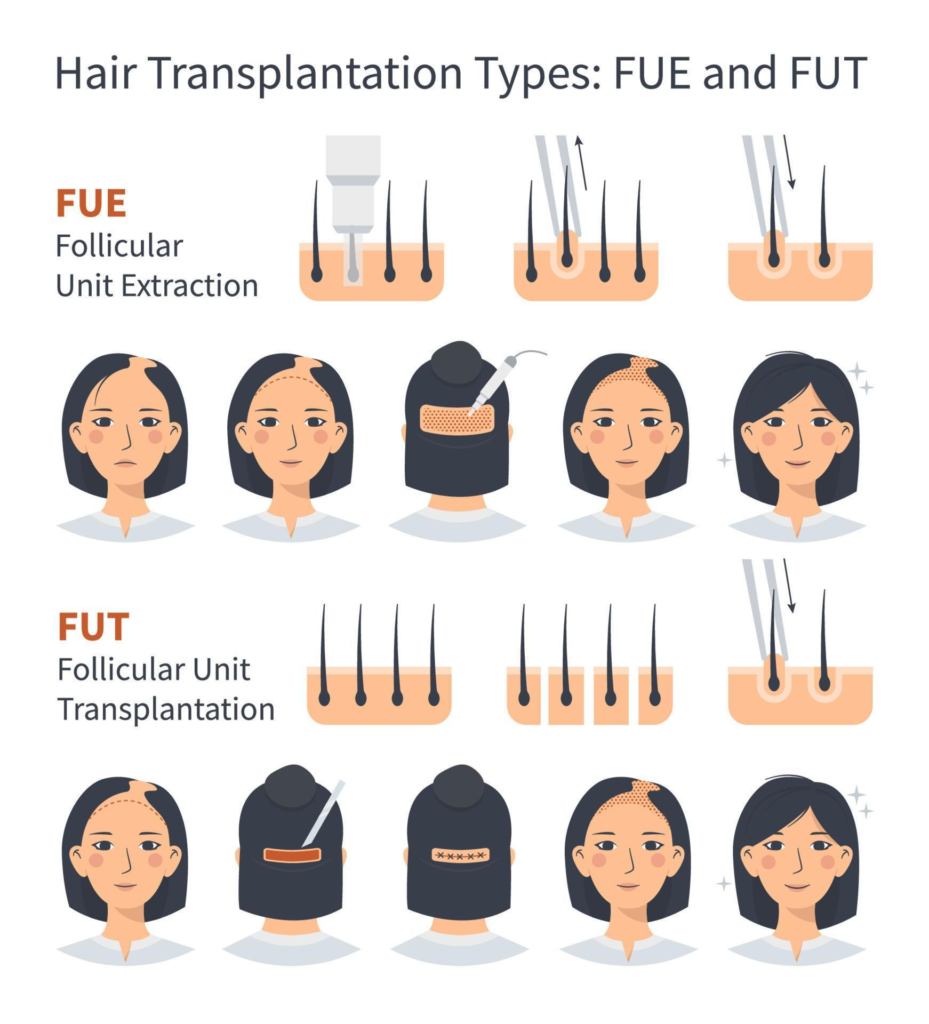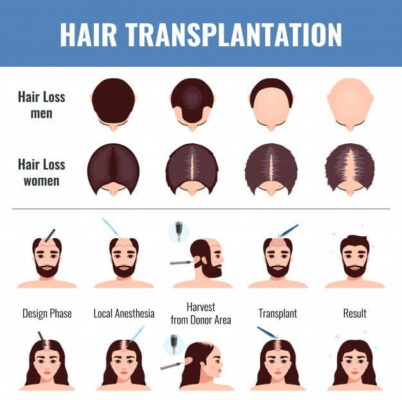Get personalized Consultation!
Female Hair Transplantation
At Vida Skin and Hair Transplant Clinic, we specialize in providing effective solutions for female hair loss through hair transplantation.
Our team of experienced professionals understands the unique challenges faced by women experiencing hair loss and is dedicated to providing personalized treatments to help them regain their confidence and achieve natural-looking results.
What are the steps and stages for a Female Hair Transplantation?
Female hair transplantation is a multi-step process that involves several stages to ensure the best possible outcome. Here is a breakdown of the steps involved:
- Consultation: The first step is a thorough consultation with our hair transplant specialist. During this initial meeting, your medical history, hair loss patterns, and expectations will be discussed. Our specialist will assess the condition of your scalp and determine the most suitable approach for your specific needs.
- Donor Area Selection: The next step is to identify a suitable donor area from where healthy hair follicles can be extracted. In most cases, the back of the head is chosen as the donor site, as this area is typically unaffected by hair loss.
- Follicle Extraction: Once the donor area is identified, a local anesthetic will be administered to ensure a painless procedure. The hair follicles will be extracted using either the FUE (Follicular Unit Extraction) or FUT (Follicular Unit Transplantation) method, depending on your individual requirements.
- Site Preparation: Following the extraction, the recipient area will be prepared for the transplantation process. Tiny incisions will be made in the target area to accommodate the transplanted hair follicles.
- Hair Transplantation: The extracted hair follicles will then be carefully transplanted into the prepared incisions in the recipient area. Special attention will be given to the angle, direction, and density of the transplanted follicles to ensure a natural-looking result.
- Post-Transplant Care: After the transplantation is complete, specific post-operative instructions will be provided to promote optimal healing and hair growth. These may include guidelines for medication, washing, and protecting the transplanted area.
Types of Female Hair Transplantation
Several techniques are available for female hair transplantation, including:
- Follicular Unit Extraction (FUE): This method involves extracting individual hair follicles from the donor area and transplanting them onto the recipient site. FUE is minimally invasive and leaves no linear scars, making it a popular choice for many women.
- Follicular Unit Transplantation (FUT): FUT involves removing a linear strip of hair-bearing scalp from the donor area and dissecting it into individual follicular units for transplantation. This technique is suited for women with larger areas of hair loss but may result in a fine linear scar.
- Direct Hair Implantation (DHI): DHI is a technique where the hair follicles are extracted and immediately implanted into the recipient area using a specialized tool. This method minimizes the time the hair follicles are outside the body, potentially promoting better survival rates.

Preparing for Female Hair Transplantation
To ensure a successful and smooth hair transplantation process, it is important to prepare adequately beforehand:
- Consultation: Schedule a consultation with our hair transplant specialist to discuss your hair loss concerns, expectations, and medical history. This will help determine if you are an ideal candidate for the procedure.
- Discontinue Medications: Certain medications, such as blood thinners or aspirin, may interfere with the hair transplantation process. It is advisable to consult with your healthcare provider to determine if any medications should be temporarily discontinued prior to the procedure.
- Arrange Transportation: Arrange for someone to drive you to and from the clinic on the day of the procedure, as you may experience some minor discomfort or drowsiness afterward.
What to Expect During Female Hair Transplantation

Undergoing a female hair transplantation can be an exciting but also a nerve-wracking experience. Here’s what you can expect during the procedure:
- Comfortable Environment: clinic provides a calm and comfortable environment to ensure your utmost relaxation during the procedure Our team is dedicated to making your experience as pleasant as possible.
- Local Anesthesia: To minimize any discomfort during the procedure, a local anesthetic will be administered to numb the donor and recipient areas. You will be awake throughout the process but should not feel any pain.
- Skillful Technique: Our highly skilled hair transplant specialist will employ advanced techniques to ensure the best possible results. With their expertise, you can expect the transplantation process to be efficient and precise.
- Duration: The duration of the procedure will depend on the extent of the transplantation required. In general, a female hair transplantation can take several hours to complete. However, rest assured that our team will prioritize your comfort and well-being at all times.
How is the hair growth after the transplant?
After a female hair transplantation, it is important to have realistic expectations regarding hair growth. Here is a general timeline of what you can expect:
- Immediate Post-Transplant Phase: In the initial weeks following the procedure, the transplanted hair follicles may go through a resting phase. It is normal for the transplanted hairs to shed during this time, as the follicles prepare for new growth.
- New Hair Growth: After the shedding phase, new hair growth typically begins within three to four months. Initially, the hair may appear thin and sparse, but it will gradually thicken and become more robust over time.
- Full Results: It may take up to a year or longer to see the full results of the transplantation. Patience is key, as hair growth varies from person to person. However, the wait is well worth it, as the final outcome will be natural-looking and long-lasting.
Aftercare and Recovery from Female Hair Transplantation
Proper aftercare is crucial for optimal healing and hair growth after a female hair transplantation. Here are some important aspects of aftercare and what to expect during the recovery period:
- Medications: Your hair transplant specialist may prescribe medications, such as antibiotics or anti-inflammatory drugs, to prevent infection and minimize swelling or discomfort. Follow the prescribed dosage and schedule accordingly.
- Physical Activity: It is important to avoid strenuous physical activity, heavy lifting, or activities that may increase blood pressure for the first few weeks after the procedure. This helps promote proper healing of the transplanted hair follicles.
- Hair Care Routine: Your specialist will provide specific instructions on how to care for your hair during the recovery period. This may include gentle washing techniques, avoiding harsh hair products, and refraining from styling or coloring the hair for a certain period.
- Follow-up Appointments: Regular follow-up appointments will be scheduled to monitor your progress and address any concerns or questions you may have. These appointments are essential for ensuring the best possible outcome.
Tips for the patient after the hair transplant
To optimize the healing process and ensure the best results after a female hair transplantation, here are some important tips to follow:
- Follow Post-Operative Instructions: It is crucial to adhere to the post-operative instructions provided by your hair transplant specialist. This may include avoiding certain activities, using specific medications, and following a proper hair care routine.
- Gentle Hair Washing: You will be advised on when and how to wash your hair after the transplant. It is important to handle the transplanted area with care and use only the recommended products to prevent any damage or displacement of the new grafts.
- Sun Protection: The transplanted area may be more sensitive to the sun’s harmful rays. Protect your scalp from prolonged exposure to direct sunlight by wearing a hat or using sunscreen to avoid sunburn or damage.
- Patience and Consistency: Hair growth after a transplantation takes time and varies from person to person. It is vital to remain patient and consistent with your aftercare routine to ensure the best possible results.
Benefits and Risks of Female Hair Transplantation
Like any medical procedure, female hair transplantation has both benefits and risks to consider:
Benefits:
- Restores Confidence: By addressing hair loss, a female hair transplantation can significantly boost self-esteem and restore confidence in one’s appearance.
- Natural Results: The advanced techniques used in hair transplantation result in natural-looking hair that blends seamlessly with existing hair.
- Long-Term Solution: Once the transplanted hair follicles establish themselves, they are resistant to further hair loss, providing a long-term solution for hair restoration.
Risks:
- Infection: Although rare, there is a slight risk of infection at the donor or recipient site. Strict adherence to post-operative care instructions minimizes this risk.
- Scarring: While efforts are made to minimize scarring, there is a possibility of small scars at the donor and recipient areas. These are usually minimal and easily concealed.
Do's and Don'ts
To maximize the success of your female hair transplantation, here are some important do’s and don’ts to keep in mind:
Do’s:
- Follow the post-operative instructions provided by your hair transplant specialist.
- Be patient and consistent in your aftercare routine.
- Maintain a healthy lifestyle and diet to support hair growth.
- Attend all scheduled follow-up appointments.
Don’ts:
- Don’t pick or scratch at the transplanted area, as this can interfere with healing and potentially dislodge grafts.
- Avoid using harsh hair products, including excessive heat styling or chemical treatments, until fully healed.
- Don’t expose the transplanted area to direct sunlight without adequate protection.
It is essential to consult with a hair transplant specialist to determine the most suitable technique based on your individual needs and goals.
Female hair transplantation offers a viable solution for women experiencing hair loss. With advancements in techniques and the expertise of professionals at Vida Skin and Hair Transplant Clinic, you can regain your confidence and achieve natural-looking results.
By following proper aftercare and being patient throughout the process, you can soon enjoy the benefits of a fuller, healthier head of hair.
Frequently Asked Questions!
Female Hair Transplantation is a cosmetic procedure aimed at addressing hair loss in women. It involves the extraction of hair follicles from donor areas, typically the back of the scalp, and transplanting them to areas with thinning or no hair to achieve fuller and natural-looking hair growth.
Women experiencing hair thinning, pattern baldness, or hair loss due to various factors may be suitable candidates. A consultation with a qualified surgeon helps determine candidacy based on individual factors like the extent of hair loss and overall health.
Patients can expect to see initial signs of new hair growth within a few weeks to a month after the transplant. However, full and noticeable results often become apparent over several months as the transplanted hair follicles go through their natural growth cycle.
Yes, Female Hair Transplantation provides a permanent solution. The transplanted hair follicles are typically resistant to the hormones causing hair loss, offering a long-term remedy for thinning or lost hair.
Recovery varies among individuals, but most women can resume their regular activities within a week. Temporary redness and swelling may occur initially. Following post-operative care instructions is crucial for optimal healing and results.
While generally safe, as with any surgical procedure, there are potential risks. These may include infection, scarring, or temporary shock loss (temporary shedding of transplanted hair). Choosing an experienced surgeon can significantly minimize these risks.
Yes, skilled surgeons can create a natural-looking hairline by strategically placing transplanted hair follicles to mimic the natural hair growth pattern. This requires expertise and an understanding of facial features and hair aesthetics.
The duration varies but typically takes several hours. Factors such as the extent of transplantation and the method used contribute to the overall time. Planning for a day off for the procedure and a brief recovery period is advisable.
Once the transplanted hair grows, it can be treated like natural hair. Coloring and styling are permissible, providing the freedom to achieve desired looks while enjoying the benefits of restored hair.
Yes, non-surgical alternatives include topical treatments, medications, and laser therapies. However, the effectiveness may vary, and Female Hair Transplantation often stands out as a more permanent and reliable solution for significant hair loss or thinning.